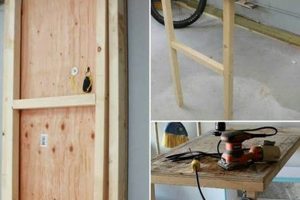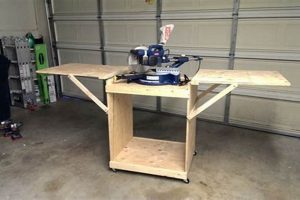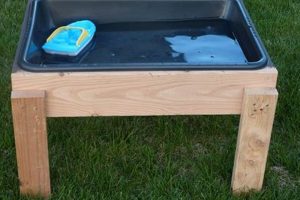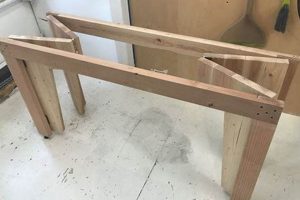The act of independently constructing a circular tabletop is a common pursuit among woodworking enthusiasts. This endeavor involves selecting materials such as wood, metal, or even repurposed items, followed by cutting, shaping, and finishing to achieve a desired aesthetic. For example, one might use reclaimed barn wood to create a rustic-style surface for dining.
Creating surfaces independently offers several advantages, including cost savings, customization options, and the personal satisfaction derived from completing a hands-on project. Historically, crafting furniture at home was a necessity, evolving into a valued hobby and a means to express individual style. The result often reflects a higher degree of personalization than mass-produced alternatives.
The subsequent sections will delve into practical aspects of crafting such a tabletop, covering material selection, precise cutting techniques, methods for achieving a smooth finish, and options for attaching legs or a base to complete the furnishing. Considerations for safety and project planning will also be addressed.
Tips for Crafting a Circular Surface Independently
The following recommendations aim to guide individuals in the successful creation of a circular tabletop, emphasizing precision, material knowledge, and adherence to safety protocols.
Tip 1: Precise Measurement and Planning: Prior to commencement, meticulously measure the intended space and calculate the desired diameter. Accurate measurements are crucial for achieving the correct scale and proportions. Employ a compass or trammel to ensure the circle is drawn perfectly.
Tip 2: Material Selection Considerations: The choice of material influences the final product’s durability and aesthetic. Hardwoods like oak or maple offer longevity, while softwoods like pine are more economical but require greater care. Consider plywood as a stable and cost-effective option for larger diameters.
Tip 3: Cutting Techniques and Tools: Employ a router with a circle-cutting jig for clean, accurate cuts. Alternatively, a jigsaw can be used, but requires careful guidance and sanding to eliminate imperfections. Always wear appropriate safety glasses and respiratory protection.
Tip 4: Edge Treatment and Finishing: The edges significantly impact the overall look. Consider options such as routing a decorative edge, applying edge banding, or simply sanding smooth. A consistent finish is essential; apply multiple thin coats of sealant or varnish for durability and appearance.
Tip 5: Secure Leg Attachment: Ensure the legs or base are securely fastened to the underside. Use appropriate hardware and techniques, such as mortise and tenon joints or heavy-duty screws with metal plates, to provide stability and prevent wobbling.
Tip 6: Sanding and Surface Preparation: Prior to finishing, meticulously sand the surface to remove imperfections and create a smooth texture. Start with a coarser grit sandpaper and gradually progress to finer grits for an optimal result. Dust removal between sanding stages is essential.
Tip 7: Environmental Factors: Be mindful of environmental conditions, particularly humidity. Wood expands and contracts with changes in humidity, which can affect the stability and appearance of the tabletop over time. Consider using kiln-dried lumber and applying a moisture-resistant finish.
Adhering to these tips will enhance the likelihood of producing a functional and aesthetically pleasing piece. Careful planning and execution are paramount to a successful outcome.
The subsequent discussion will address specific design considerations and innovative applications of independently crafted circular surfaces.
1. Material Durability
The selection of materials with adequate durability is paramount to the success of any independent circular tabletop construction project. Material choice directly affects the finished piece’s resistance to physical damage, water intrusion, and general wear, thereby influencing its lifespan and suitability for the intended application. For instance, utilizing a softwood like pine for a heavily used dining surface is likely to result in premature scratching and denting, necessitating frequent repairs or eventual replacement. Conversely, employing a hardwood such as maple or oak, while potentially more expensive, provides significantly greater resistance to such damage. The practical significance of understanding material durability lies in ensuring that the completed tabletop meets the demands of its environment and usage.
Specific examples illustrate the connection further. Consider a tabletop crafted from reclaimed wood. While aesthetically appealing, reclaimed wood may possess inherent weaknesses from prior use or exposure to the elements. Thorough inspection and reinforcement, if necessary, are crucial to ensure structural integrity. Alternatively, engineered wood products, such as plywood or MDF, offer consistent strength and dimensional stability, making them suitable for projects requiring large, flat surfaces. The selection process should involve a careful evaluation of the material’s density, hardness, and resistance to moisture, as well as its capacity to support the intended load.
In summary, material durability is not merely a desirable attribute, but a fundamental requirement for a successful independent circular tabletop endeavor. Neglecting this aspect can lead to functional failures, diminished aesthetic appeal, and ultimately, a shortened lifespan for the finished product. A comprehensive understanding of material properties and their influence on durability is therefore essential for any individual undertaking such a project, ensuring a long-lasting and satisfying outcome.
2. Cutting Precision
In the context of independently constructing circular tabletops, cutting precision assumes a role of paramount importance. It directly determines the accuracy of the resulting circular form, impacting both the aesthetic appeal and the structural integrity of the piece. A deviation from the intended circular shape, resulting from imprecise cutting, will manifest as visual asymmetry or, in extreme cases, compromise the tabletop’s ability to evenly distribute weight. Real-world examples abound; a tabletop exhibiting noticeable flat spots or irregular curves immediately detracts from its perceived quality and professional appearance. Furthermore, in instances where the tabletop is intended to fit within a specific frame or receive a circular insert, even minor inaccuracies in the cut can render the piece unusable.
The achievement of cutting precision necessitates the selection of appropriate tools and techniques. A router equipped with a trammel jig offers a high degree of accuracy, allowing for controlled and consistent cutting along a predetermined radius. Alternatively, a band saw or jigsaw may be employed, but these methods require greater skill and attention to detail to minimize deviations from the intended shape. Regardless of the tool selected, meticulous measurement and marking are essential prerequisites. The marked line serves as a guide for the cutting process, and any error in its placement will be directly translated into an inaccuracy in the finished tabletop. Moreover, consistent blade speed and pressure are critical for maintaining a smooth and even cut, preventing chipping or splintering of the material.
In conclusion, cutting precision is not merely a desirable attribute in the independent construction of circular tabletops; it is a fundamental requirement for achieving a successful outcome. The accuracy of the circular shape directly influences the tabletop’s aesthetic appeal, structural integrity, and overall functionality. Understanding the relationship between cutting techniques, tool selection, and the resulting precision is therefore essential for any individual undertaking such a project. Addressing the challenges associated with achieving precise cuts, through careful planning and execution, is crucial for producing a high-quality, visually pleasing, and structurally sound circular surface.
3. Surface Smoothness
Surface smoothness is a critical attribute of any independently constructed circular tabletop. It directly influences the tactile experience, the visual appeal, and the overall functionality of the finished piece. The degree of smoothness achieved reflects the quality of craftsmanship and the attention to detail invested in the project.
- Tactile Comfort and Usability
A smooth surface enhances tactile comfort, making the tabletop pleasant to touch and interact with. A rough or uneven surface can be uncomfortable or even hazardous, potentially snagging clothing or causing splinters. For example, a dining surface with a rough finish would be less desirable than one that is smooth and inviting. Proper sanding and finishing techniques are essential to achieve a surface that is both functional and enjoyable to use. The application of multiple thin coats of sealant, each followed by fine sanding, is a common approach to achieving this objective.
- Aesthetic Appeal and Visual Quality
Surface smoothness directly impacts the tabletop’s visual appeal. A smooth, even surface reflects light evenly, enhancing the clarity and depth of the finish. Imperfections such as scratches, gouges, or uneven sanding marks can detract from the visual quality of the piece. Polishing techniques and the use of appropriate finishes can significantly improve the reflective properties of the surface, creating a more visually appealing result. In contrast, a poorly finished surface will appear dull and lifeless, regardless of the quality of the underlying material.
- Cleanability and Maintenance
A smooth surface is easier to clean and maintain. Dirt, spills, and other contaminants are less likely to become embedded in a smooth surface, making them easier to wipe away. Rough surfaces, on the other hand, can trap dirt and grime, requiring more aggressive cleaning methods that may damage the finish. The application of a durable, smooth finish can significantly reduce the amount of maintenance required to keep the tabletop looking its best. For instance, a sealed and polished surface can be easily wiped clean with a damp cloth, whereas an unfinished or roughly finished surface may require scrubbing or the use of specialized cleaning products.
- Finish Adhesion and Longevity
Surface smoothness promotes better adhesion of finishes, enhancing their longevity. A smooth, properly prepared surface provides a solid foundation for the finish to bond to, preventing peeling, chipping, or cracking. Rough surfaces, on the other hand, may have loose fibers or debris that interfere with the finish’s ability to adhere properly. Proper sanding and surface preparation are therefore essential for ensuring that the finish provides adequate protection and maintains its appearance over time. The use of a primer or sealer can further improve finish adhesion and enhance its durability.
In summary, surface smoothness is not simply an aesthetic consideration in the independent construction of circular tabletops. It is a fundamental attribute that affects the tactile experience, visual appeal, cleanability, and longevity of the finished piece. Neglecting surface preparation and finishing techniques can result in a tabletop that is uncomfortable to use, visually unappealing, difficult to maintain, and prone to premature wear. A commitment to achieving a smooth, even surface is therefore essential for anyone seeking to create a high-quality, long-lasting circular tabletop.
4. Edge Finishing
Edge finishing is a crucial component in independently crafting circular tabletops. It dictates the visual appeal, tactile quality, and, to a lesser extent, the long-term durability of the piece. The method of edge treatment directly impacts the overall aesthetic; a sharp, unfinished edge presents a starkly different impression than a rounded, smooth profile. The chosen finishing technique can complement the wood grain, enhance the tabletop’s perceived value, and provide a safe, comfortable surface for users. A poorly finished edge detracts from the overall craftsmanship, creating a negative tactile experience and potentially posing a safety hazard.
The selection of an appropriate edge finishing method depends on several factors, including the material used, the intended style, and the available tools. A router with various bits can create a wide range of profiles, from simple roundovers to more elaborate decorative edges. Edge banding, typically applied to plywood or MDF tabletops, conceals the core material and provides a clean, finished look. Sanding, while essential in all cases, is particularly important when a more subtle, rounded edge is desired. For example, a farmhouse-style tabletop might feature a slightly rounded edge achieved through sanding, while a modern design might call for a sharp, clean edge achieved with a router and minimal sanding. The application of a suitable finish, such as varnish or oil, protects the edge from moisture and wear, further enhancing its durability.
In summary, edge finishing is an integral aspect of independently constructed circular tabletops, influencing both aesthetic and functional qualities. The chosen technique should complement the overall design and material, enhancing the piece’s visual appeal and providing a comfortable, safe surface. A well-executed edge finish demonstrates attention to detail and significantly elevates the overall quality of the project, ensuring a lasting and satisfying result. Disregarding the importance of this stage can detract from an otherwise well-constructed tabletop, highlighting the need for careful planning and execution in every phase of the creation process.
5. Base Stability
Base stability constitutes a fundamental requirement for a functional and safe independently constructed circular tabletop. The stability of the base directly impacts the overall usability and longevity of the piece. Insufficient stability results in a tabletop that is prone to wobbling, tipping, or even collapsing under load, rendering it unsuitable for its intended purpose. The structural integrity of the connection between the tabletop and the base is, therefore, paramount. Real-world examples illustrate the importance of this aspect; a dining surface that shifts unexpectedly during a meal creates a disruptive and potentially hazardous experience. Similarly, a work surface that is unstable compromises the precision and safety of any task performed upon it.
Achieving adequate base stability necessitates careful consideration of several factors, including the size and weight of the tabletop, the design and construction of the base, and the method of attachment. Larger or heavier tabletops require more robust bases with wider footprints to prevent tipping. The material used for the base also plays a significant role; metal or solid wood bases provide greater stability than lighter, less rigid alternatives. The attachment method must ensure a secure and lasting connection between the tabletop and the base. Options include the use of screws, bolts, or specialized hardware designed for joining wood or metal. Mortise and tenon joints, or similar joinery techniques, offer exceptional strength and stability but require more advanced woodworking skills.
In conclusion, base stability is not a secondary consideration but an essential element in the successful creation of a independently constructed circular tabletop. Its absence compromises the functionality, safety, and overall value of the finished product. Careful planning, selection of appropriate materials and construction techniques, and meticulous execution are all critical for ensuring that the base provides adequate support and stability for the tabletop. By prioritizing base stability, individuals can create circular surfaces that are not only aesthetically pleasing but also safe, durable, and enjoyable to use for years to come.
6. Joint Strength
Joint strength is a critical factor influencing the structural integrity and longevity of any independently constructed circular tabletop. The ability of joints to withstand stress and resist failure directly impacts the stability, safety, and overall usability of the finished piece. Understanding the principles of joint strength and employing appropriate techniques is therefore essential for individuals undertaking such projects.
- Type of Joint Selection
The choice of joint significantly affects the strength and durability of the connection between the tabletop and its base or between individual components of the tabletop itself. Options include mortise and tenon joints, dowel joints, biscuit joints, and simple screw connections. Mortise and tenon joints, known for their exceptional strength, are often employed in high-stress applications. Dowel and biscuit joints provide adequate strength for less demanding connections. Screw connections offer simplicity and ease of assembly but may require reinforcement in certain situations. The selection process should consider the intended load, the material properties, and the skill level of the individual constructing the tabletop.
- Adhesive Application and Selection
The adhesive used to bond joints plays a crucial role in their overall strength. Different types of adhesives offer varying levels of bond strength, water resistance, and heat resistance. Wood glue, epoxy, and polyurethane adhesives are commonly used in woodworking applications. Wood glue provides adequate strength for most interior applications, while epoxy offers superior strength and water resistance, making it suitable for exterior use. Proper adhesive application is essential for maximizing joint strength. This includes ensuring clean and dry surfaces, applying an even layer of adhesive, and clamping the joint securely until the adhesive has fully cured. Insufficient adhesive or improper clamping can result in a weak and unreliable joint.
- Load Distribution and Stress Points
The design of the tabletop and its base should consider load distribution and minimize stress points on joints. Concentrated loads can overstress joints, leading to premature failure. Distributing the load evenly across multiple joints can significantly improve the overall strength and stability of the structure. Reinforcing joints with metal plates, gussets, or additional fasteners can further enhance their ability to withstand stress. Careful consideration of load distribution is particularly important for larger or heavier tabletops.
- Material Compatibility and Preparation
The compatibility of the materials being joined and proper surface preparation are essential for achieving strong and durable joints. Certain wood species may not bond well with certain adhesives. Oily woods, for example, may require special surface preparation to ensure adequate adhesive penetration. Surfaces should be clean, dry, and free of any contaminants that could interfere with the bonding process. Sanding or roughing up the surfaces can improve adhesive adhesion and joint strength. Neglecting material compatibility and surface preparation can result in weak and unreliable joints, regardless of the quality of the adhesive or the type of joint used.
These facets highlight that joint strength is a complex interplay of design choices, material properties, adhesive selection, and construction techniques. Successfully incorporating these elements contributes significantly to the creation of a sturdy and long-lasting independently constructed circular tabletop. Addressing potential weaknesses in joint construction is crucial for ensuring the finished piece can withstand the rigors of daily use and remain a functional and aesthetically pleasing element within the intended environment.
7. Protective Coating
The application of a protective coating is an indispensable step in the independent construction of circular tabletops. This layer serves as a barrier against environmental factors and physical wear, significantly influencing the tabletop’s longevity and aesthetic appeal. The absence of a protective coating exposes the underlying material to moisture, ultraviolet radiation, scratches, and stains, leading to premature degradation. For example, a wooden surface left uncoated will absorb spills, causing swelling, warping, and discoloration. Similarly, direct sunlight will fade the color and weaken the structure of unprotected wood. The practical significance of applying a protective coating lies in preserving the integrity of the tabletop and extending its service life.
Protective coatings are diverse, each offering specific advantages and disadvantages. Polyurethane provides a durable, water-resistant finish suitable for high-traffic surfaces. Varnish offers a traditional aesthetic and good protection against scratches. Oil-based finishes penetrate the wood, enhancing its natural beauty while providing some protection against moisture. The selection of a coating depends on the material of the tabletop, the intended use, and the desired aesthetic. For example, a dining tabletop requires a durable, water-resistant coating like polyurethane, while a decorative tabletop might benefit from an oil-based finish that highlights the wood grain. The application process is also crucial; multiple thin coats, properly cured, provide better protection than a single thick coat.
In summary, a protective coating is not merely an optional enhancement but a critical component in the creation of a durable and aesthetically pleasing independently constructed circular tabletop. It safeguards the material from damage, preserves its appearance, and extends its lifespan. Proper selection and application of the coating are essential for achieving optimal results, ensuring the tabletop remains a functional and attractive element within its intended environment for years to come. Understanding the properties and application techniques of various protective coatings is, therefore, a fundamental aspect of successful circular tabletop construction.
Frequently Asked Questions Regarding DIY Table Round Construction
The following section addresses common inquiries and misconceptions related to the independent construction of circular tabletops, providing factual information and practical guidance.
Question 1: What is the minimum recommended thickness for a tabletop?
The minimum recommended thickness is contingent upon the tabletop’s diameter and intended use. A general guideline suggests a minimum of 3/4 inch for smaller diameters (under 36 inches) and 1 inch or greater for larger diameters (over 48 inches). Load-bearing requirements must also be considered.
Question 2: Which wood species are most suitable for tabletop construction?
Hardwoods such as oak, maple, and cherry are generally preferred due to their durability and resistance to wear. Softwoods like pine are suitable for decorative purposes or when cost is a primary concern but require greater care to prevent damage. Engineered wood products like plywood offer stability and affordability.
Question 3: How can a perfectly circular shape be ensured?
Employing a router with a circle-cutting jig or a trammel is the most reliable method for achieving a perfectly circular shape. Alternatively, a compass and careful jigsaw work, followed by sanding, can yield acceptable results. Precise measurements and a steady hand are crucial.
Question 4: What type of finish is recommended for a dining tabletop?
A durable, water-resistant finish such as polyurethane is generally recommended for dining surfaces. This finish provides protection against spills and scratches. Multiple thin coats are preferable to a single thick coat for optimal results. Consider food-safe finishes where direct contact with food is anticipated.
Question 5: How can tabletop warping be prevented?
Using kiln-dried lumber and applying a sealant to all surfaces, including the underside, can minimize the risk of warping. Avoiding drastic changes in humidity and temperature is also crucial. For larger diameters, consider using thicker materials or incorporating structural supports.
Question 6: What are the key considerations for attaching legs to a tabletop?
The attachment method must ensure a secure and lasting connection. Options include screws, bolts, or specialized hardware designed for joining wood or metal. Mortise and tenon joints, or similar joinery techniques, offer exceptional strength and stability. Even weight distribution and preventing wobble are paramount.
Accurate execution is paramount in independent tabletop construction.
The succeeding section will explore practical steps for building a unique tabletop.
diy table round
This examination of the independent creation of circular tabletops has addressed essential aspects, ranging from material selection and cutting precision to surface finishing, base stability, joint strength, and protective coatings. Emphasizing the interconnectedness of these elements, it highlighted their collective influence on the durability, functionality, and aesthetic value of the finished product. A meticulous approach to each stage is paramount.
The independent construction of a circular tabletop represents a significant undertaking, demanding a combination of technical skill, informed decision-making, and unwavering attention to detail. Successful execution yields a functional and aesthetically pleasing furnishing, reflecting both individual craftsmanship and a commitment to enduring quality. Further exploration and practical application of these principles are encouraged.







